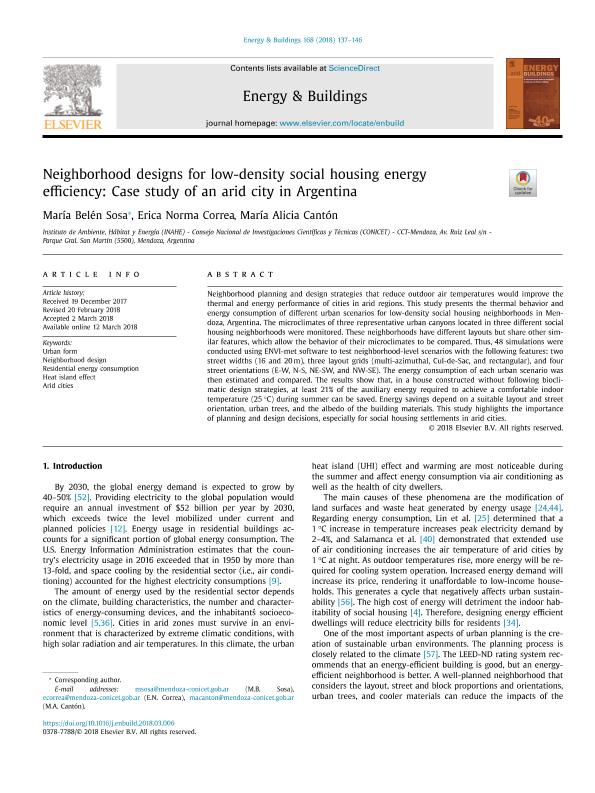Mostrar el registro sencillo del ítem
dc.contributor.author
Sosa, María Belén

dc.contributor.author
Correa Cantaloube, Erica Norma

dc.contributor.author
Canton, Maria Alicia

dc.date.available
2019-11-04T21:00:49Z
dc.date.issued
2018-06
dc.identifier.citation
Sosa, María Belén; Correa Cantaloube, Erica Norma; Canton, Maria Alicia; Neighborhood designs for low-density social housing energy efficiency: Case study of an arid city in Argentina; Elsevier Science Sa; Energy and Buildings; 168; 6-2018; 137-146
dc.identifier.issn
0378-7788
dc.identifier.uri
http://hdl.handle.net/11336/87971
dc.description.abstract
Neighborhood planning and design strategies that reduce outdoor air temperatures would improve the thermal and energy performance of cities in arid regions. This study presents the thermal behavior and energy consumption of different urban scenarios for low-density social housing neighborhoods in Mendoza, Argentina. The microclimates of three representative urban canyons located in three different social housing neighborhoods were monitored. These neighborhoods have different layouts but share other similar features, which allow the behavior of their microclimates to be compared. Thus, 48 simulations were conducted using ENVI-met software to test neighborhood-level scenarios with the following features: two street widths (16 and 20 m), three layout grids (multi-azimuthal, Cul-de-Sac, and rectangular), and four street orientations (E-W, N-S, NE-SW, and NW-SE). The energy consumption of each urban scenario was then estimated and compared. The results show that, in a house constructed without following bioclimatic design strategies, at least 21% of the auxiliary energy required to achieve a comfortable indoor temperature (25 °C) during summer can be saved. Energy savings depend on a suitable layout and street orientation, urban trees, and the albedo of the building materials. This study highlights the importance of planning and design decisions, especially for social housing settlements in arid cities.
dc.format
application/pdf
dc.language.iso
eng
dc.publisher
Elsevier Science Sa

dc.rights
info:eu-repo/semantics/openAccess
dc.rights.uri
https://creativecommons.org/licenses/by-nc-nd/2.5/ar/
dc.subject
ARID CITIES
dc.subject
HEAT ISLAND EFFECT
dc.subject
NEIGHBORHOOD DESIGN
dc.subject
RESIDENTIAL ENERGY CONSUMPTION
dc.subject
URBAN FORM
dc.subject.classification
Otras Ingeniería del Medio Ambiente

dc.subject.classification
Ingeniería del Medio Ambiente

dc.subject.classification
INGENIERÍAS Y TECNOLOGÍAS

dc.title
Neighborhood designs for low-density social housing energy efficiency: Case study of an arid city in Argentina
dc.type
info:eu-repo/semantics/article
dc.type
info:ar-repo/semantics/artículo
dc.type
info:eu-repo/semantics/publishedVersion
dc.date.updated
2019-10-18T18:33:14Z
dc.journal.volume
168
dc.journal.pagination
137-146
dc.journal.pais
Países Bajos

dc.journal.ciudad
Amsterdam
dc.description.fil
Fil: Sosa, María Belén. Consejo Nacional de Investigaciones Científicas y Técnicas. Centro Científico Tecnológico Conicet - Mendoza. Instituto de Ambiente, Hábitat y Energía; Argentina
dc.description.fil
Fil: Correa Cantaloube, Erica Norma. Consejo Nacional de Investigaciones Científicas y Técnicas. Centro Científico Tecnológico Conicet - Mendoza. Instituto de Ambiente, Hábitat y Energía; Argentina
dc.description.fil
Fil: Canton, Maria Alicia. Consejo Nacional de Investigaciones Científicas y Técnicas. Centro Científico Tecnológico Conicet - Mendoza. Instituto de Ambiente, Hábitat y Energía; Argentina
dc.journal.title
Energy and Buildings

dc.relation.alternativeid
info:eu-repo/semantics/altIdentifier/url/www.sciencedirect.cwom/science/article/pii/S0378778817340732
dc.relation.alternativeid
info:eu-repo/semantics/altIdentifier/doi/http://dx.doi.org/10.1016/j.enbuild.2018.03.006
Archivos asociados
